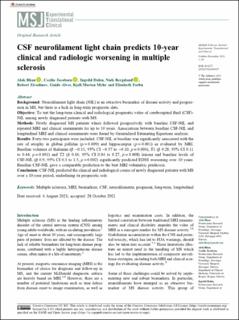CSF neurofilament light chain predicts 10-year clinical and radiologic worsening in multiple sclerosis
Bhan, Alok; Jacobsen, Cecilie; Dalen, Ingvild; Bergsland, Niels; Zivadinov, Robert; Alves, Guido Werner; Myhr, Kjell-Morten; Farbu, Elisabeth
Journal article, Peer reviewed
Published version

Åpne
Permanent lenke
https://hdl.handle.net/11250/2838440Utgivelsesdato
2021Metadata
Vis full innførselSamlinger
- Department of Clinical Medicine [2066]
- Registrations from Cristin [9791]
Originalversjon
Multiple Sclerosis Journal, Experimental, Translational and Clinical. 2021, 7 (4). 10.1177/20552173211060337Sammendrag
Background
Neurofilament light chain (NfL) is an attractive biomarker of disease activity and progression in MS, but there is a lack in long-term prognostic data.
Objective
To test the long-term clinical and radiological prognostic value of cerebrospinal fluid (CSF)-NfL among newly diagnosed patients with MS.
Methods
Newly diagnosed MS patients where followed prospectively with baseline CSF-NfL and repeated MRI and clinical assessments for up to 10 years. Associations between baseline CSF-NfL and longitudinal MRI and clinical assessments were found by Generalized Estimating Equations analysis.
Results
Forty-two participants were included. CSF-NfL at baseline was significantly associated with the rate of atrophy in globus pallidus (p = 0.009) and hippocampus (p = 0.001) as evaluated by MRI. Baseline volumes of thalamus (β −0.33; 95% CI −0.57 to −0.10, p = 0.006), T1 (β 0.28; 95% CI 0.11 to 0.44, p = 0.001) and T2 (β 0.16; 95% CI 0.04 to 0.27, p = 0.008) lesions and baseline levels of CSF-NfL (β 0.9; 95% CI 0.3 to 1.5, p = 0.002) significantly predicted EDSS worsening over 10 years. Baseline CSF-NfL gave a comparable prediction to the best MRI volumetric predictors.
Conclusion
CSF-NfL predicted the clinical and radiological course of newly diagnosed patients with MS over a 10-year period, underlining its prognostic role.
